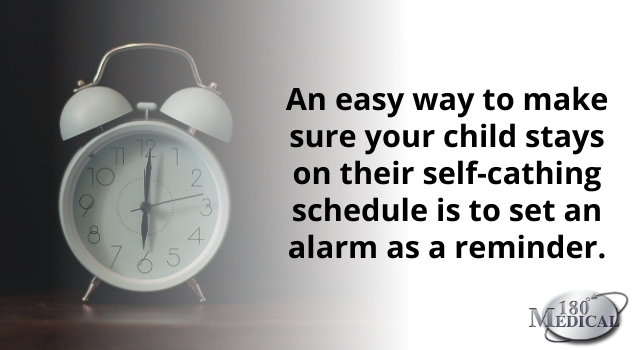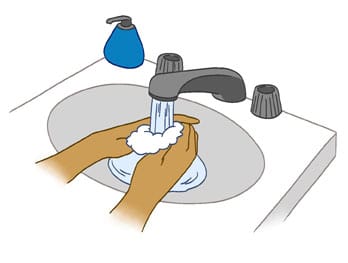Does your child need catheters to drain their bladder? Are they at an age where they’re ready to take over their bladder management routine and learn to self-cath?
While you may be in charge of your child’s prescribed intermittent catheterization routine for their first formative years, you may wonder when is the right time or age for them to learn to self-cath on their own.
Some children as young as 5 years old successfully self-cath daily. However, reaching a certain age is actually not as important as a few other factors that can indicate if they are ready to self-catheterize. This includes your child’s level of reliability and responsibility. Also, they need to be physically able to cath on their own. Plus, they may demonstrate a desire for more independence by wanting to learn to intermittently catheterize on their own.
Activities to Test If Your Child is Ready to Learn to Self-Cath
Louisa Salvin, an RN in the Pediatric Urology Department at SSM Cardinal Glennon Medical Center, has graciously provided some helpful tips. This may help you determine if your child is physically ready to begin self-cathing.
“Certain physical and mental abilities are required in order to successfully learn to do self-catheterization,” says Louisa.
She recommends trying these different activities to determine if your child may be ready to learn:
- Hold a pencil with a pincer grasp and do up and down strokes.
- Thread a shoelace.
- With eyes closed, feel a hole and place a peg in it.
- With your child watching you, place three objects in a bag. Do something else for a few minutes. Then have your child tell you what’s in the bag and in what order the objects were placed in the bag.
Tips to Help Your Child Learn to Self-Cath
If your child seems physically ready to start using catheters all on their own, let’s move on. Next, make sure they have all the materials and information they need to take over their self-cathing routine on their own while maintaining proper hygiene and privacy.
Tip 1. First, see your child’s doctor.
Because catheters are prescription-only medical devices, start by seeing a doctor if you haven’t already. They can tell you how many times per day your child should cath as well as what size catheter to use. Plus, they can go over the process of how to use catheters together with you and your child.
Once you get home, if you need more step-by-step instructions for learning how to self-catheterize, 180 Medical offers free online pediatric catheterization instructions.
If you’re unsure if your child is ready to learn to self-catheterize, our blog post, Is Your Child Ready to Learn to Self-Cath?, has some helpful tips from Registered Nurse Louisa Salvin.
Tip 2. Normalize the process of cathing.
When you’re a kid, the last thing you want is to be different. Living with a disability or another medical condition can sometimes put your difference on constant display for everybody to see. When we’re told we also have to use a catheter, it’s just one more difference we have to face.
Your child is facing a challenge in learning how to self-catheterize. Support them by keeping an open line of communication and letting them know they’re not alone.
A great starting point for your child to learn how to self-cath will be to sign up for the 180 Medical Kids Club. This awesome program was created just for you and your child to begin adjusting to the new process of independently cathing.
Right off the bat, you will receive a drawstring backpack filled with one-of-a-kind educational materials and activities, along with a few additional fun surprises, and your child can begin learning more about Ethan & Emma, 180 Medical’s own storybook characters who help emphasize the normality of using catheters.
The Kids’ Club also teaches proper hygiene when using pediatric catheter supplies.
Tip 3. Make a self-catheterization schedule and set reminders.
After getting a prescription, create a schedule for cathing at certain times of the day every day. You’ll want to base this on the prescribed number of times per day your child should cath.
Some parents and caregivers like to set an alarm on their child’s watch or phone. Having automatic reminders like this is an easy way to make sure your child always knows when it’s time to go to the bathroom.

Tip 4. Plan in advance for when your child is at school.
When I’m talking to families about their children learning to self-catheterize, it’s the part about using catheters at school or away from home that seems to be the most challenging. However, it’s still very doable.
If your child is going to school, communicate their needs with their teacher and/or their school nurse. They can make accommodations, such as storing your child’s catheter supplies privately. This keeps your child from having to carry their supplies around all day.
Personally, when I was in elementary school, I was able to use the restroom at the school nurse’s office. This is where I also stored my supplies so I wouldn’t have to carry them around all the time or have my friends see them. That simple step made me feel more confident in handling my own program at school. Plus, an added bonus of that arrangement is that it gave my parents some control because the nurse would update them if I wasn’t following through on my self-catheterization program.
The next step is to reinforce your plan with the importance of commitment and compliance. By doing this, you and your child may find that self-catheterizing will become easier over time. You may even notice that fewer accidents occur as your child gets used to self-cathing on a schedule.
However, to make that happen, you both have to make an honest effort to follow the prescribed cathing plan. Remember, kids can easily get sidetracked at school or a friend’s house. If they get distracted, they may neglect their self-cathing routine.
Tip 4. Make sure they understand proper hygiene.
Talk with your child about their hygiene before and after cathing, particularly washing their hands thoroughly. You may also look into supplying your child with gloves and/or antiseptic wipes to reduce the risk of urinary tract infections or spreading germs.
Washing your hands with soap and water before cathing and wearing sterile gloves can go far in helping to reduce the risk of infection. Using a “touchless” closed system catheter with an insertion tip can also greatly reduce the risk of recurrence of UTIs. Give us a call to discuss your product options!

Tip 5. Address any concerns or issues your child may be having.
As your child adjusts to the new routine of self-cathing, it’s normal to hit some snags or bumps in the road. You might hear some complaints like “My friends will know” or “Cathing takes forever.”
Assure your kid that their friends don’t have to know unless they decide to tell them. They don’t have to tell anybody about their personal needs. However, if your child chooses to share that information with a friend, let them know that any good friend will understand and care that this process is what keeps you healthy.
If they feel that self-cathing takes too long, I like to say, “What takes longer? Taking a few minutes to use a catheter, or having to go clean up after an accident because you didn’t cath?” In other words, nobody keeps track of how long you’re in the restroom, but they may notice if you have an accident and have to go spend time cleaning up.

To the parents and caregivers out there, be honest with your kids that cathing is a different routine they just have to do. Never sugarcoat the importance of making sure they follow the program. As kids, we all know recognize when our parents mean what they say, so consistency is important.
Early on, there will be accidents, some forgetfulness, and maybe even a little stubbornness. However, if you stay committed to the program, so will your kid.
Where to Get Pediatric Catheter Supplies
Ready to find the right pediatric catheters for your child? 180 Medical has been specializing in intermittent catheters, incontinence supplies, and ostomy products for nearly 20 years. We have experience in helping children as young as newborns. We’re here to help you and your child find the best intermittent catheters to fit their unique needs.
If you have any other questions or would like more information, contact our friendly specialists.


